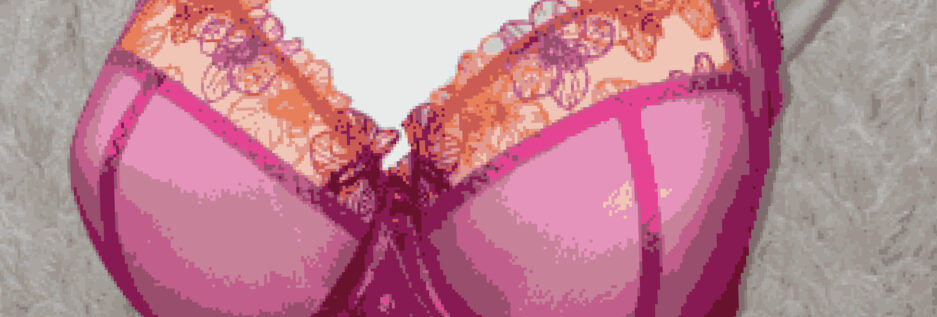This is such a pretty style. Here is my Kwik Sew 3300:

I think it looks so pretty with the black and white theme. The lace was a gift, and the floral stretch lace is from a local fabric store. All other material supplies are from Bra Makers Supply.
It’s pretty, but there were a couple of fitting issues. One really wasn’t a biggie. This bra had the straps pinned up about 2 inches here in the picture – so I shortened those.
The bigger fitting issue is the upper part of the cup is loose. I could pinch a quarter-inch out of the upper cup. That shouldn’t be too hard to fix on the pattern, and thankfully it doesn’t show when I wear it. This style actually fits similarly to how a foam cup bra fits.

You can see here where I pinned the cup.
The steps I took beforehand really helped me to get the cup to fit properly. Here’s what I did for this bra (and some of this is from past posts, but I’m putting it all together here):
The first thing I did was sew up a muslin for the cups. I did this twice. After looking at the pattern pieces, and picking the one I thought was closest to my size, I sewed up my first muslin. I used some scrap cotton I had left over from a skirt muslin I’d made. On this first one I could see how much I would need to adjust the pattern along the wire line. Remember, I my wear one size bra for the cups, but my wire size does not match that – it’s quite a bit smaller. So that was my first adjustment.
After I altered the pattern I sewed up another cup muslin. Again, I used some left over cotton, but this time it was from one of my moulages. This second one I pinned over an existing well-fitting bra. It was a pretty good fit at this point. But still needed a bit of adjustment. On this second muslin I drew where the seam lines fell underneath it. Again, dealing with an Omega shape means most patterns don’t fit the way they are.

At this point I was pretty sure I had the right size and shape for me. And I was really close.
This bra has a vertical seam, so no upper and lower cup, but instead and inside and outside cup. I was using lace for both the inside and outside cups, so I lined them both with sheer cup lining. That made both cups completely non-stretch to give it the support it needed. I’ve done this before on all lace bras, and it works great. I usually don’t use Lycra because I don’t find it offers the support needed, but using this sheer cup lining would be a great option for under Lycra too.
At this point I was feeling quite confident that this bra was going to fit without any issues. You see, most of my issues have been the bridge and the adjustments I needed for the Omega shape. I haven’t run into this looseness before.
I didn’t use the band that came with the pattern. I used the one I know fits wells. I now have a custom bridge that is working great for me and I wasn’t going to mess with that. As well, I drafted the cradle on my band to fit a Vertical wire and a custom bridge. After all the work to get the band to fit so well, there was no way I was going to try another band! All I was really wanted was to insert the 3300 cups into my band for a different look.
Even though this bra pattern still needs some tweaking, the steps I took ahead of time really were worth all the effort. And if you have challenges with fitting, I really recommend this method of fitting the bra cups. A shout out to Sigrid for sharing this. And after much searching, I realized it was not in her blog, but on Pattern Review. She explained this when she reviewed Merckwaerdigh’s BHST2 pattern. Really a great tip!
Happy Creating!
